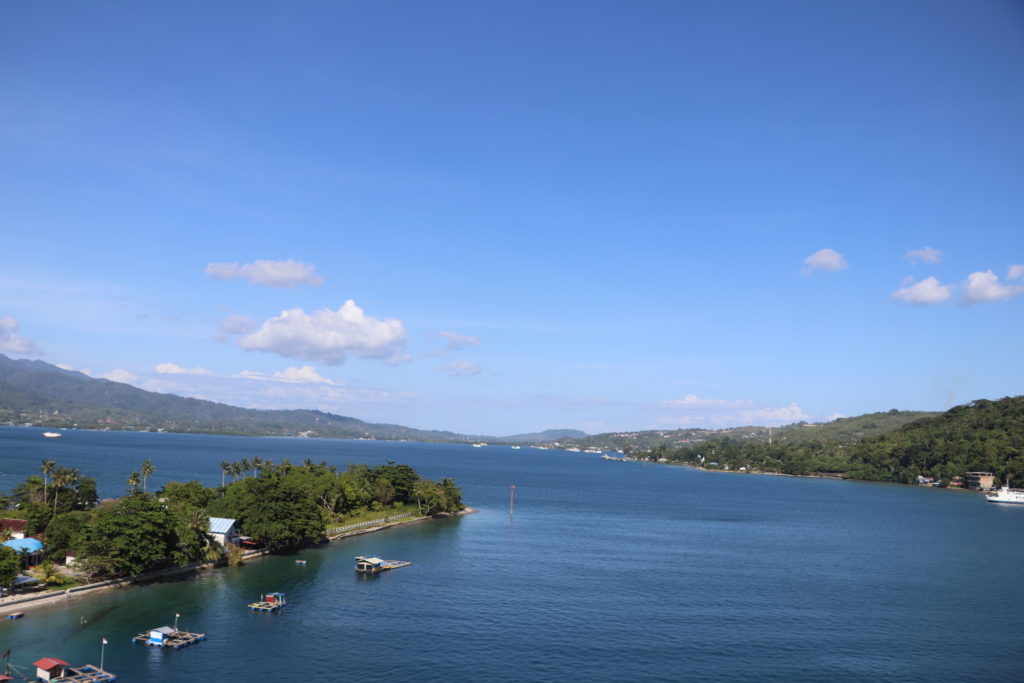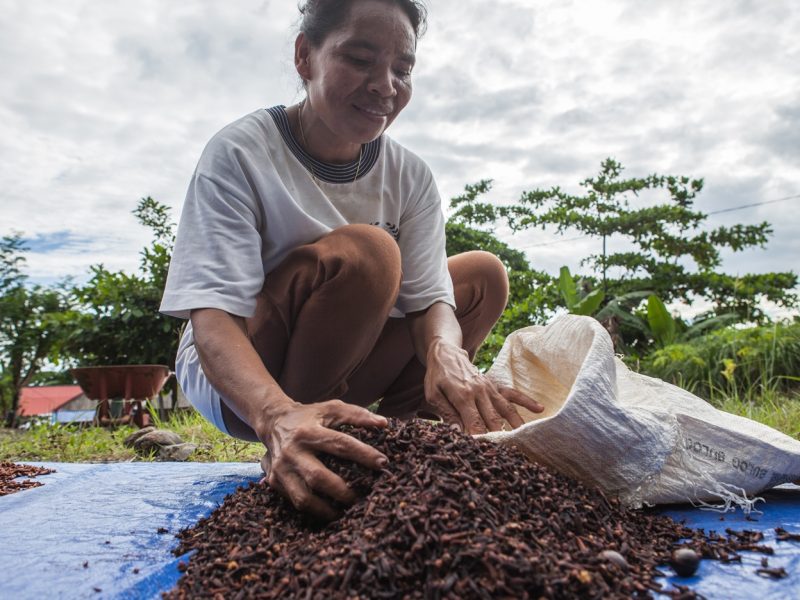In Maluku Province in far eastern Indonesia, an increasingly erratic climate has left clove farmers unable to depend on the spice that put this region on the map.
By Rezza Aji Pratama
The sun that beat down on Ambon Island in the middle of January was intense, with temperatures reaching as high as 34 degrees Celsius.
Irawan Ruhuputty, 33, a farmer in Negeri Tial in Ambon, Central Maluku, pointed to a dried-out clove tree on the verge of death. Most of its leaves had fallen off, with only brownish-yellow ones remaining.
“I don’t know whether this is caused by a disease or it’s too hot. If this happens, [the tree] will usually die,” Irawan said during an interview in January.
Cloves are native to the Maluku Islands. They grow naturally from the shoreline far into the mountains and are not cultivated in plantations like other commodities, such as palm oil.
Clove as well as nutmeg have an important meaning for the people of Maluku. Before the 18th century, all the world’s clove and nutmeg supplies only came from this part of Indonesia, better known by traders as the Spice Islands. Because of their importance, the people of Maluku would store their crops as collateral, selling them only when there was an urgent need or when they wanted to finance a big celebration, such as a wedding.
However, in recent years it has become increasingly difficult for farmers to horde their cloves, let alone fulfill their daily needs. Annual clove yields are no longer certain. In a good year farmers can earn tens of millions of rupiah, but more often they can barely cover the costs of the labor needed to harvest the cloves.
In the September 2019 harvest, Irwan’s family was only able to collect about 10 kilograms of cloves on their roughly one hectare of land, said Irwan’s father, 54-year-old Thalib Ruhuputty.
The family has been cultivating cloves for hundreds of years in Central Maluku Regency – though over time their total land area has been farmed out to various family member through inheritance. During last September’s harvest, clove yields were selling for Rp70,000 (US$4.70) per kilogram, so Irwan and Thalib were only able to earn Rp700,000 (US$47).
“I don’t have any stored [clove] left. I have sold them all for our daily neccesity,” Thalib added.
The situation is not so bad for everyone. Apik Soulisa, 55, harvested one ton of dried cloves from a garden of just more than one hectare.

Why do clove yields on Ambon Island fluctuate? Ireng Darwati, a plant physiology researcher from the Ministry of Agriculture’s Spices and Medicinal Plants Research Institute (Balittro), explained that fluctuations caused by variations in climate change affect their hormones and gene expression.
In addition to climate factors, especially temperature and rainfall, crop maintenance patterns also greatly affect crop yields. Because cloves in Maluku have tradtionally grown without special care, farmers are not accustomed to using fertilizer or watering their trees.
Climate phenomena, such as El Nino and La Nina, are increasingly adding to the problem. When El Nino hit in 2015, Apik could only reap tens of kilograms of dried cloves from the same garden.
A climate-sensitive crop
At the beginning of each year, farmers anxiously wait for the next harvest. If the heat lasts until March – no more no less – they can breathe easily. Clove flowers can grow well and yields will be abundant.
However, in recent years the weather has become increasingly erratic. Early summer, which is usually hot, can see sudden rainfall. Excess amounts of rain will prevent clove trees from flowering, turning the buds into leaves. If the dry season is too long, the clove plants will dry up and die.
“If it’s about the climate, then let’s just surrender,” said Imron Soumena, 49, secretary of Negeri Lima village.
According to Darwati, cloves are very sensitive to climate change. They require sufficient rain during the flowering process followed by a dry season for two to three months.
Prolonged summer will increase levels of the hormone abscisic acid (ABA) in the clove tree. As a result, the stomata that allow CO2 to enter the plant will close, inhibiting photosynthesis. Excessive heat also inhibits cloves from getting water and nutrition.
“The clove root is short so that if it is hot it will be difficult to get water,” Darwati said.
On the other hand, too much rain will accelerate production of the hormone gibberellin acid (GA), which affects plant growth. Too much of the GA hormone will turn new buds into leaves rather than flowers, leading to a sharp decline in the harvest.
The ideal temperature for cloves to grow is between 25-32 degrees Celsius with an average rainfall of 1,500mm – 3,500mm, said Darwati.
Historically, that makes the climate of the Maluku Islands well suited to clove cultivation. Clove plantations close to and facing the sea are also very good for growth and production, because the difference in temperature between day and night is not too great.
The problem is, the climate in the islands is increasingly erratic.
Extreme weather events increasing
“The frequency of extreme events such as El Nino and La Nina is becoming more frequent,” said Rion Salman, a researcher from the Pattimura Climatology, Meteorology and Geophysics Agency (BMKG), Ambon.
El Nino is characterized by warming surface temperatures in the Pacific Ocean. This phenomenon generally occurs every two to seven years. When El Nino occurs, rainfall and atmospheric circulation are disrupted, causing extreme climate disruption in various regions of the world.
Scientists previously estimated that highly intense forms of El Nino that can cause extreme climate chaos occur every 23 years. A number of more recent studies have shown that global warming is triggering this frequency of extreme El Niño more often.
In 2014, a group of climate researchers led by Wenju Cai from the Commonwealth Scientific and Industrial Research Organization published research results on El Nino frequencies in the journal Nature.
They used computer simulations to select 21 climate events in the 1900-1999 period and compared them with climate predictions for the 2000-2090 period based on average current emissions levels. As a result, the researchers estimated that the frequency of extreme El Niño events would be every 13 years.
Cai and his team also predicted that the variables triggering El Nino and La Nina events would become more complicated.
“Predicting El Nino and La Nina events is more difficult,” he wrote in the report.
Arief Wijaya, manager of the Forests and Climate program at the World Resource Institute’s Indonesia office, explained that because El Nino events are very closely related to the increase in global temperatures, their frequency and intensity are expected to increase as long as greenhouse gas emissions continue driving temperatures up.
Without any serious policy measures to reduce emissions, the earth’s temperature is predicted to rise beyond 3 degrees Celsius from pre-industrial levels by 2030, said Arief.
“Plants that live in a certain temperature range will not survive if it is too hot. Maybe cloves and nutmeg are one of them, “he added.
What about conditions in the Maluku Islands? To monitor the level of drought in an area, scientists rely on several methods. One of the most popular is the Standardized Precipitation Index (SPI). The index developed by TB McKee, NJ Doesken and J. Kleist of Colorade State University in 1993 measures the level of rainfall or precipitation that occurs in a region within a certain period of time.
If the index is between – 0.99 to + 0.99 conditions are defined as normal. If it’s above 1, it indicates wet conditions, while greater than -1 means the region is in a dry condition. In the short term, SPI is closely related to soil moisture. In the longer term, SPI helps monitor groundwater availability.
Data from the Climate Hazards Group at the University of California, Santa Barbara that is available on Resource Watch, an open-source data visualization platform supported by World Resource Watch, shows that during the last 15 years the problems faced by the Maluku Islands were not only drought. Conditions that are too wet often occur. In 2008 and 2017, for example, Maluku SPI reached 2.4 and 2, respectively, indicating very wet conditions.
Be on the lookout for El Nino
The most recent intense El Nino occurred in 2015. Yet El Nino is different from a heat wave. This phenomenon makes rainfall decline, causing lengthy drought. In the worst cases, some residents’ clove gardens caught fire.
West Seram Climatology Station Foreman Steven Cahya said that the impact of the 2015 El Nino was very much felt in the Maluku Islands.
“This [El Nino 2015] is a phenomenon with the strongest intensity ever recorded; stronger than El Nino 1997-1998,” he said through an email reply to questions on Feb. 8.
In July 2015, all BMKG stations in Maluku detected sub-normal rainfall that occurred in all regions in the province, Cahya explained. Analysis in August 2015 also showed a lack of groundwater availability.
“The normal value of each region in each month is different, but it is said to be below normal when the rainfall that occurs is less than 85 percent than usual,” Cahya explained.
In general, El Nino delays the start of rainy season.
This phenomenon is clearly very detrimental to the finances of people whose jobs depend on climate conditions. A report by the United States Agency for International Development (USAID) titled “Climate and Non-Climate Impacts on Clove and Nutmeg Productivity in Maluku Province” released in 2017 said clove and nutmeg production in Maluku fell by 70 percent at the time of El Nino 2015.
Marcus Pattinama, one of the researchers, explained that the decline in the productivity of cloves and nutmegs was compounded by inadequate cropping practices.
“Farmers do not use agricultural production facilities, such as certified seeds, superior seeds and adequate fertilizer. The arrangement and spacing are also irregular. Clove spacing is too tight, between 6 x 6 m to 9 x 9 m,” said Pattinama, who is also a professor of ethnobotany at Pattimura University, Ambon.
“In addition, there is no maintenance and sanitation of plants from pests and diseases. This non-intensive cultivation practice can reduce crop productivity,” he added.
Even though cloves should be treated intensively, Darwati from Balittro said the soil around the clove tree should not be cleaned too often to maintain moisture.
During periods of excessive rainfall, farmers are recommended to use chemical retardant, paclobutrazol, a plant-organ inhibitor that blocks the biosynthesis of gibrelin, one of the phytohormones that stimulates vegetative growth in clove trees.
“High rainfall causes the growth of clove plant vegetation to increase so that it will block the expression of flowering genes,” he said.
Why do farmers not apply adequate cropping patterns? Soumena, the secretary of Negeri Lima village, said that clove farmers typically follow practices passed down through the generations. Cloves are also considered legacy crops that do not need to be treated, he said. The location of clove farms far from settlements also prevents farmers from carrying out routine maintenance.
“During this time we just let it grow naturally. There were also no agricultural extension workers who came to help,” Soumena stressed. “Indeed, this is how we have farmed since [the time of] our ancestors.”
* This is a translation of a story that was originally published on Jaring.id on May 8, 2020. This version has been edited for length and clarity.
Reporting for this coverage was supported by a grant from the Earth Journalism Network and Resource Watch, a non-profit organization that focuses on research in the area of sustainability.
